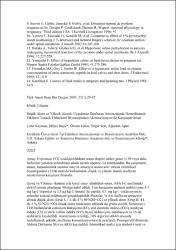| dc.contributor.author | Kaymak, Çetin | |
| dc.contributor.author | Başar, Hülya | |
| dc.contributor.author | Tekin, Özlem | |
| dc.contributor.author | Sert, Özgür | |
| dc.contributor.author | Apan, Alpaslan | |
| dc.date.accessioned | 2020-06-25T14:33:30Z | |
| dc.date.available | 2020-06-25T14:33:30Z | |
| dc.date.issued | 2007 | |
| dc.identifier.citation | Kaymak, Ç., Başar, H., Tekin, Ö., Sert, Ö., Apan, A. (2007). Düşük akım ve yüksek akımla uygulanan desfluran anestezisinde hemodinamik etkilerin torasik elektriksel biyoempedans monitorizasyon ile karşılaştırılması. Türk Anestezi ve Reanimasyon Dergisi, 35(1), 29 - 37. | en_US |
| dc.identifier.issn | 1304-0871 | |
| dc.identifier.issn | 1305-614X | |
| dc.identifier.uri | https://app.trdizin.gov.tr/publication/paper/detail/TmpVNU5EQXc= | |
| dc.identifier.uri | https://hdl.handle.net/20.500.12587/421 | |
| dc.description.abstract | Amaç: Expiratuar CO2 uzaklaştırıldıktan sonra ekspire edilen gazın % 50 veya daha fazlasının yeniden solutulması düşük akımlı anestezi ile mümkündür. Bu çalışmanın amacı, hemodinamik monitorizasyon amacıyla noninvaziv torasik elektriksel biyoempedans (TEB) metodu kullanılarak, düşük ve yüksek akımlı desfluran anestezisinin karşılaştırılmasıdır. Gereç ve Yöntem: Hastane etik kurul onayı alındıktan sonra, ASA I-II sınıfındaki elektif cerrahi planlanan 40 olgu dahil edildi. Tüm hastaların anestezi indüksiyonu 5-7 mg kg-1 tiopental ve 1,5 µg kg-1 fentanil ile yapıldı. 0.1 mg kg-1 veküronyum iv ardından trakeal entübasyon gerçekleştirildi. Hastalar, % 4-6 desfluran anestezisi altında düşük akım (Grup I, 1 L dk-1 % 50 N2OO2) ve yüksek akım (Grup II, 4 L dk-1 % 50 N2OO2) olmak üzere randomize edilerek iki gruba ayrıldı. Noninvaziv TEB kullanılarak ejeksiyon fraksiyonu (EF), end-diastolik indeks (EDI), kardiyak indeks (CI) ve strok volüm indeks (SVI) bazal, indüksiyon, entübasyon ve 15 dk. aralıklarla kaydedildi. Anestezinin derinliği, BIS değerleri 40-60 arasında hedeflenerek şekilde, desfluran konsantrasyonlarıyla ayarlandı. Postoperatif dönemde Aldrete Derlenme Skoru (ARS) kaydedildi. İstatistiksel analiz için student-t testi ve tekrarlayan ölçümlerde varyans analizi kullanıldı. p0.05 istatistiksel olarak anlamlı kabul edildi. Bulgular: End-tidal desfluran konsantrasyonları, Grup II'de, 45. ve 60. dk. değerlerinde, Grup I'e göre anlamlı olarak yüksekti (p0.05). Grup I'deki 45. ve 60. dk. EDI, Grup II'ye göre anlamlı olarak yüksekti (p0.05). CI, SVI ve EF değerleri, her iki grup arasında benzer bulundu. Grup I'de 5. ve 10. dakikalardaki ARS anlamlı olarak yüksekti. Sonuç: Desfluran ile düşük ve yüksek akımlı anestezi tekniğinde, TEB metodu kullanılarak benzer hemodinamik etkiler olduğu sonucuna vardık. | en_US |
| dc.description.abstract | Background and Goal of Study: After the removal of exhaled CO2, rebreathing of 50 % or more of exhaled gases is possible during low flow anaesthesia. The purpose of this study is to compare the thoracic electrical bioimpedance (TEB) method for hemodynamic monitoring under low flow and high flow desflurane anaesthesia. Material and Methods: After Institutional Ethics Committee approval, 40 ASA I-II patients scheduled for elective surgery were included into the study. For all patients, anaesthesia was induced with 1.5 µg kg-1 fentanyl and 5-7 mg kg-1 thiopenthal. The trachea was intubated after 0,1 mg kg-1 vecuronium. Patients were randomly divided into two groups to receive low flow (1 L min-1 50 % N2OO2) in group I or high flow (4 L min-1 50 % N2OO2) in group II with 4-6 %. Ejection fractions (EF), end-diastolic indexes (EDI), cardiac indexes (CI), stroke indexes (SI) were monitored and recorded with noninvasive TEB for basal, induction, intubations and 15 min. intervals. The level of anaesthesia was adjusted by the concentration of desflurane to achieve a target BIS in the range of 40-60. Postoperative Aldrete Recovery Score (ARS) was recorded. Student-t test and repeated measures of variance were used to statistical analysis. p<0.05 was accepted statisticaly significant. Results: The concentrations of end-tidal desflurane in group II were significantly higher than group I at the 45th and 60th minutes (p<0.05). The EDI at 45th and 60th minutes in group I were significantly higher than group II (p<0.05). The values of CI, SVI and EF were similar in group I and II. The ARS at 5th and 10th minutes were significantly higher in group I. Conclusion: We concluded that low flow or high flow anaesthesia technique by desflurane has similar hemodynamic effects by using TEB method. | en_US |
| dc.language.iso | tur | en_US |
| dc.rights | info:eu-repo/semantics/openAccess | en_US |
| dc.subject | Cerrahi | en_US |
| dc.title | Düşük akım ve yüksek akımla uygulanan desfluran anestezisinde hemodinamik etkilerin torasik elektriksel biyoempedans monitorizasyon ile karşılaştırılması | en_US |
| dc.title.alternative | Comparison of hemodynamic effects with thoracic electrical bioimpedance monitoring in desflurane anaesthesia applied with low and high flow | en_US |
| dc.type | article | en_US |
| dc.contributor.department | Kırıkkale Üniversitesi | en_US |
| dc.identifier.volume | 35 | en_US |
| dc.identifier.issue | 1 | en_US |
| dc.identifier.startpage | 29 | en_US |
| dc.identifier.endpage | 37 | en_US |
| dc.relation.journal | Türk Anestezi ve Reanimasyon Dergisi | en_US |
| dc.relation.publicationcategory | Makale - Ulusal Hakemli Dergi - Kurum Öğretim Elemanı | en_US |
















